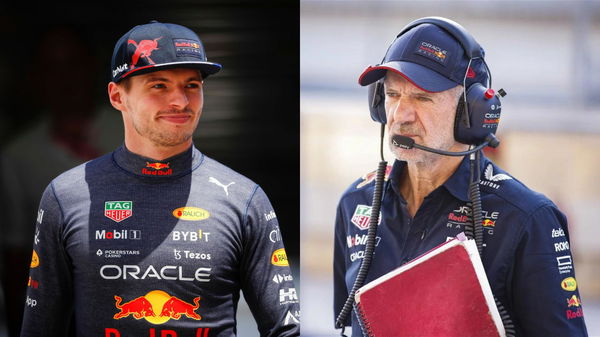
via Imago
Max Verstappen (L), Adrian Newey (R) | Image Courtesy: Imago

via Imago
Max Verstappen (L), Adrian Newey (R) | Image Courtesy: Imago
In this season comprised of 22 races, Red Bull has won all but one so far, with one more race to go. While Max Verstappen is in his biggest purple patch, the car underneath him is also the most dominant car this season. While it is true that Perez isn’t always in the top 2, the car is without a doubt the best car on the grid. The Adrian Newey-led engineering team did a wonderful job creating this rocketship.
However, when the regulations first came about in 2020 for the new specifications, Adrian Newey revealed it was depressing. Speaking on the Chequered Flag podcast, he talks about the recent regulation changes that allowed for closer following in dirty air, and how Red Bull managed to overcome the “depressing” conundrum.
ADVERTISEMENT
Article continues below this ad
Adrian Newey’s perspective on the ground effect regulations
When the rules were first revealed in 2020, the initial outlook was not great according to Newey. The Milton Keynes team CTO reveals, “When I first saw the rules in 2020, in the initial days, they looked pretty depressing from an engineering point of view. In the first sight, they looked very restrictive.” From this perspective, fans can question if further changes didn’t come through, would all the cars have similar concepts?
However, that is a what-if scenario for now. Newey immediately explains that the rules were loosened up in the subsequent days, to enable at least some differentiation. Even otherwise, Newey revealed that once you got into the nuances, there was enough allowances for flexibility to ensure engineering brilliance shone through.
“The rules were freed up a little bit just to allow visual differentiation, which I think is a very good thing,” describes Newey. “Once you get into the details, it became apparent that there’s actually decent amount of flexibility within that.”
When asked what made his cars better than the others, Newey responded that it was about getting the fundamentals right. He adds, “We decided to go upfront with a short rear, which is opposite to what most cars were in the previous rules. We felt that was best suited to the aerodynamics of the car. We managed to get the fundamentals of the car right when it came out last year.”
He also revealed that they put in more time than anything else into the 2021 car, leaving them with little time to adapt to the new regulations. That sense of hurry, according to Newey, added a huge benefit for the rest of the season.
ADVERTISEMENT
Article continues below this ad
Newey’s vision for developing Red Bull’s beast
Since they had spent comparatively less time developing the car for the new season, Red Bull focused only on getting the fundamentals right. Since they only focused on this, they could take an evolutionary approach through the rest of the last season and this season to develop and get everything else right.

via Reuters
Formula One F1 – Hungarian Grand Prix – Hungaroring, Budapest, Hungary – July 31, 2022. Red Bull’s Max Verstappen with Red Bull Chief Technical Officer Adrian Newey after the race. REUTERS/Lisa Leutner
When last season started, Ferraris looked extremely competitive and at some stages even faster than Red Bull. However, thanks to this approach, the Milton Keynes team was able to quickly bridge the gap, and pull ahead of the others by a mile. Despite how dominant this car is, Newey doesn’t think this is Red Bull’s best car. He looks back to the 2009 car, the RB-9, which provided the basis for winning the championships for four consecutive years. Meanwhile, the Briton also stated last year that someone else might design a better car to beat RBR.
ADVERTISEMENT
Article continues below this ad
WATCH THIS STORY | Max Verstappen Wittily Responds to Backlash for 2021 Championship Win
A year & another championship double later, that prophesy seems to be in the bin at least for 2023. Going ahead to the Abu Dhabi Grand Prix, Red Bull will be the one team that can afford to take it easy. They’ve already sealed the top spot in the constructors’ championship, and P1 & 2 in the drivers’ as well. With 2023 ending, and 2024 coming in a couple of months, it will definitely be interesting to see if the Red Bull will continue to be as dominant.
ADVERTISEMENT
ADVERTISEMENT
ADVERTISEMENT
ADVERTISEMENT

